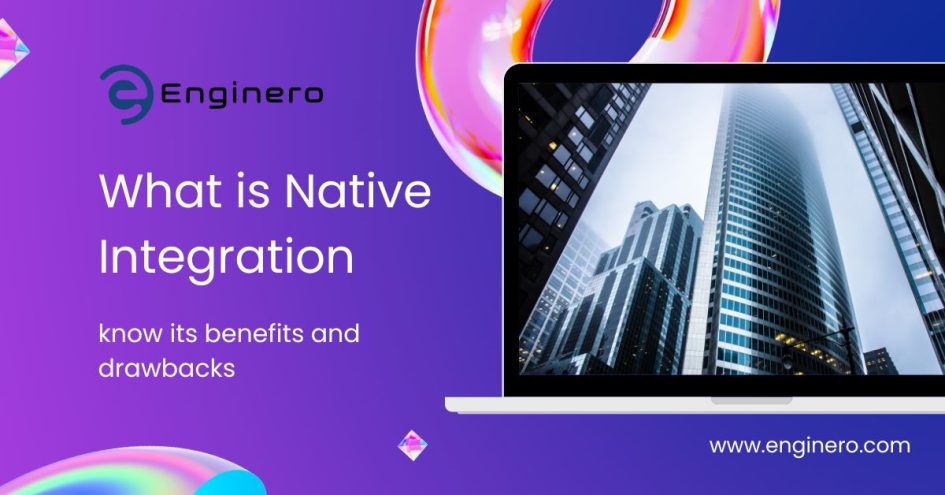In recent years, the utilization of CAD and BIM has grown to an extent. These tools use the most efficient way of bringing up all these designs: an effective approach called Native Integration. Native Integration brings you a lot of advanced features and a huge bunch of benefits.
Let us jump into this article, where you can briefly overview native integration, its importance and benefits, and how Enginero helps you integrate your various construction and mechanical designs into a central system.
Table of Contents
What is Native Integration?
Native Integration is API integration involving seamless interoperability and communication between different software products and solutions.
Native Integration allows you to seamlessly exchange technical data, commands, and various functionalities without external connectors or middleware.
With Native integration, you can ensure more efficient workflows, mitigate errors, and improve efficiency in your projects.
In the design industry, Native integration is widely used in Digital transformation by integrating various CAD and BIM models effortlessly and facilitating interdisciplinary collaboration.
Importance of Native Integration in the Design Sector
Native Integration greatly helps in engineering design projects, improving collaboration and productivity.
In file-sharing, designs will be shared as a complete file, whereas in native integration, only the design particulars will be replicated on the unified platform. This helps users share their changes and publish without updating the whole design file.
Compatibility issues and manual work are reduced by integrating your native design tools within a unified platform for review and validation. With this, you can save a lot of time and ensure that you collaborate with teams with fewer barriers.
In addition to that, it fosters collaboration with different stakeholders by allowing them to interact with each other and help review and provide feedback frequently.
Integrating your CAD and BIM software into a common platform simplifies the workflows and ensures a consistent process throughout the lifecycle.

Benefits of Native Integration
Native integration provides significant benefits to construction and design projects. Some of these are:
Streamlined Workflows:
Integrating different teams with their respective design files will streamline the workflow and enhance productivity by reducing redundant tasks and automating repetitive processes.
With this, the project’s momentum will increase throughout the lifecycle, from the initial design to the final validation phase.
Native Operability:
Native integration provides various features that you can work with within your native software without switching to the common platforms.
Creating issues and raising RFI requests can be done from the application where you design and draft, simplifying the process of information gathering and conflict resolution.
Data Consistency:
With Native Integration, accuracy is maintained in the projects. As the whole project data is managed on a single platform, discrepancies and inconsistencies are minimized. This leads to efficient outcomes, improved quality, and better maintainability.
Enhanced Interoperability:
Integrating all your design software into a single platform brings all your teams into one place. This mitigates the issue of interoperability. By bringing all the files onto one platform, compatibility issues, and data loss are reduced. Native integration also eliminates the important process of converting one file into another.
Lifecycle Management:
Integrating the complete project’s data into one platform will help the stakeholders a lot in terms of decision-making and facilitation. Integrated CAD and BIM platforms support comprehensive lifecycle management of built assets.
Enhanced Coordination:
Native integration facilitates clash detection and coordination processes within the BIM environment. With a technology known as BIM Coordination, you can combine diverse designs on a single platform, helping project teams identify and resolve clashes or conflicts early in the design phase.
This proactive approach helps prevent costly rework and construction delays by addressing issues before they escalate. Automated clash detection tools streamline the process further, flagging potential conflicts based on predefined rules and criteria.
Native Integration with Enginero!
Enginero simplifies the management of CAD and BIM designs in construction projects. Users can integrate their native design software with Enginero using customized plugins. This allows them to publish models directly to Enginero’s central repository from their native design software and manage designs based on project definitions within their organization.
Designs can be categorized within each project according to design teams, and Enginero automatically categorizes design files as 3D models, drawings, and reference documents.
Project stakeholders can review the published designs in Enginero’s interactive model viewer, enabling them to validate models without opening their native design software.
This feature helps detect discrepancies in the design as issues, which can be assigned to the responsible user for resolution. The responsible user can then address the issue in the native application and publish the model again, saving time and effort.
Enginero’s Model Coordination creates coordination sets by combining the designs from different teams like Architectural, MEP, and Structural. Enginero’s built-in clash detection engine, IntelliClashTM helps you detect hard and soft clashes and resolve them automatically.
Apart from all these, Enginero’s Revit Cloud Collaboration integrates your Revit families with Enginero as common assets, which you can later utilize for your further projects by extracting them from your model.
Conclusion:
Wrapping up, it is concluded that native integration is essential to design management, especially in the engineering and construction industries.
Throughout project lifecycles, its hassle-free interoperability with different CAD and BIM systems improves productivity, collaboration, and data consistency while streamlining workflows.
Native integration, as proven by platforms like Enginero, opens the door for effective design processes with advantages ranging from improved coordination and lifecycle management to streamlined workflows.
As technology continues to evolve, embracing native integration remains pivotal for driving innovation and achieving excellence in design projects.


Leave a Reply